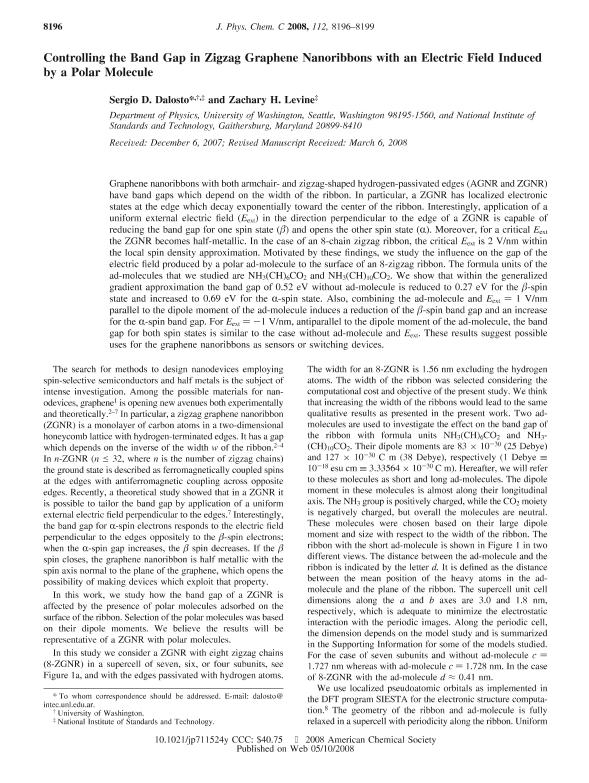Mostrar el registro sencillo del ítem
dc.contributor.author
Dalosto, Sergio Daniel

dc.contributor.author
Levine, Zachary
dc.date.available
2017-07-06T19:12:06Z
dc.date.issued
2008-05
dc.identifier.citation
Dalosto, Sergio Daniel; Levine, Zachary; Controlling the Band Gap in Zigzag Graphene Nanoribbons with an Electric Field Induced by a Polar Molecule; American Chemical Society; Journal of Physical Chemistry C; 112; 22; 5-2008; 8196-8199
dc.identifier.issn
1932-7447
dc.identifier.uri
http://hdl.handle.net/11336/19785
dc.description.abstract
Graphene nanoribbons with both armchair- and zigzag-shaped hydrogen-passivated edges (AGNR and ZGNR) have band gaps which depend on the width of the ribbon. In particular, a ZGNR has localized electronic states at the edge which decay exponentially toward the center of the ribbon. Interestingly, application of a uniform external electric field (Eext) in the direction perpendicular to the edge of a ZGNR is capable of reducing the band gap for one spin state (beta) and opens the other spin state (alpha). Moreover, for a critical Eext the ZGNR becomes half-metallic. In the case of an 8-chain zigzag ribbon, the critical Eext is 2 V/nm within the local spin density approximation. Motivated by these findings, we study the influence on the gap of the electric field produced by a polar ad-molecule to the surface of an 8-zigzag ribbon. The formula units of the ad-molecules that we studied are NH3(CH)6CO2 and NH3(CH)10CO2. We show that within the generalized gradient approximation the band gap of 0.52 eV without ad-molecule is reduced to 0.27 eV for the beta-spin state and increased to 0.69 eV for the R-spin state. Also, combining the ad-molecule and Eext ) 1 V/nm parallel to the dipole moment of the ad-molecule induces a reduction of the beta-spin band gap and an increase for the R-spin band gap. For Eext ) -1 V/nm, antiparallel to the dipole moment of the ad-molecule, the band gap for both spin states is similar to the case without ad-molecule and Eext. These results suggest possible uses for the graphene nanoribbons as sensors or switching devices.
dc.format
application/pdf
dc.language.iso
eng
dc.publisher
American Chemical Society

dc.rights
info:eu-repo/semantics/openAccess
dc.rights.uri
https://creativecommons.org/licenses/by-nc-sa/2.5/ar/
dc.subject
Graphene
dc.subject.classification
Otras Ciencias Físicas

dc.subject.classification
Ciencias Físicas

dc.subject.classification
CIENCIAS NATURALES Y EXACTAS

dc.title
Controlling the Band Gap in Zigzag Graphene Nanoribbons with an Electric Field Induced by a Polar Molecule
dc.type
info:eu-repo/semantics/article
dc.type
info:ar-repo/semantics/artículo
dc.type
info:eu-repo/semantics/publishedVersion
dc.date.updated
2017-06-29T13:36:22Z
dc.journal.volume
112
dc.journal.number
22
dc.journal.pagination
8196-8199
dc.journal.pais
Estados Unidos

dc.description.fil
Fil: Dalosto, Sergio Daniel. Consejo Nacional de Investigaciones Científicas y Técnicas. Centro Científico Tecnológico Conicet - Santa Fe. Instituto de Desarrollo Tecnológico para la Industria Química. Universidad Nacional del Litoral. Instituto de Desarrollo Tecnológico para la Industria Química; Argentina
dc.description.fil
Fil: Levine, Zachary. National Institute of Standards and Technology; Estados Unidos
dc.journal.title
Journal of Physical Chemistry C

dc.relation.alternativeid
info:eu-repo/semantics/altIdentifier/doi/http://dx.doi.org/10.1021/jp711524y
dc.relation.alternativeid
info:eu-repo/semantics/altIdentifier/url/http://pubs.acs.org/doi/abs/10.1021/jp711524y
Archivos asociados
